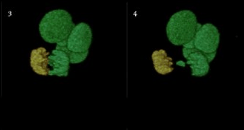The research group of Hugo Snippert reports the first detailed insights into the pace and patterns by which genetic alterations are generated by tumors. The results appear today in the leading journal Nature Genetics and shed new light on the origin of colon tumors.
A technical breakthrough now allows Hugo´s team at the Center of Molecular Medicine at UMC Utrecht to combine microscopic ‘live’ recordings of cell divisions with genetic characterization of those same individual tumor cells. This knowledge may help predict whether benign colon polyps can eventually transform into malignant cancers.
Colorectal cancer is a disease that kills nearly 5,000 people in the Netherlands each year. Although there are indications that genetic variation in these tumors is related to the severity of the disease, it was still unclear how and at what rate this variation arises. “Until now, we were not able to independently analyze the two most important variables that drive the evolution of tumors,” says research leader Hugo Snippert. “The final genetic profile of a tumor is the outcome of how often genetic alterations occur and what effect these invoke on the fitness of a tumor cell.” The effect on fitness, also known as selection, can be both positive and negative for a tumor cell. For instance, an alteration that makes cancer cells divide faster always outcompetes cells that divide slower or even die because of the alteration. “We were already capable to map the genetic outcome of that process to great extent, but how both intertwined processes independently impact the course of tumor evolution was a black box until now. For example, we had no idea of the extent of genetic variation that occurs but ultimately does not survive.”
In a new study published today in Nature Genetics, the researchers take a major step toward understanding this process. “In our study, we used cultured mini-tumors, called organoids,” explains Yannik Bollen, one of the two principal researchers in this study. “In those mini-tumors, we can make microscopic recordings of all cell divisions and then reconstruct the genetic alterations per newly formed cell.” The result is a very precise overview of how and when genetic changes occur in a tumor. “It has been assumed for a long time that genetic abnormalities in tumors accumulate in a slow, gradual manner, but we often see multiple large alterations occuring in just a single cell division.” Ellen Stelloo, the other principal researcher, outlines the spectacular impact of their work: “Mapping the intermediate genomes of an evolving tumor cell greatly enhances our understanding of the disease process of colon cancer. You can compare it to the impact that the discovery of transitional fossils like the Archaeopteryx, a feather-clad dinosaur and widely considered to be the ‘first bird’, have on our understanding of evolution.”
Microscopic recording of cell divisions in a tumor organoid. By means of ‘3D Live-Seq’ a reconstruction could be made of the genetic changes that took place in the filmed tumor organoid. The tumor in question, including the yellow marked cell nucleus (frame 1) contains 3 copies of chromosome 7. In a subsequent cell division, another incorrect distribution of chromosome 7 takes place, as a result of which the yellow marked daughter cell ends up with an extra copy of chromosome 7 (4x, frame 8) and the red with one less (2x, frame 8).
Intriguingly, the process of genetic instability in cancer cells appears not to be strictly proceeding in a step-by-step manner, but can occur with sudden, singular big jumps. “There were already indications for this in the literature. But how do you demonstrate something has never been there when you simply can’t find it? We now address that question by providing direct evidence that tumor cells can skip a lot of genetic intermediates with one cell division”, Hugo says. Now that this study has mapped the rate and patterns of genetic alterations, the team wants to focus on selection. In a follow-up study, they will explore whether it is essential for tumor development to make big jumps, or whether it could also have occurred more gradually. For the research published today, Hugo Snippert’s group collaborated with a national and international team of colleagues, including Oncode Investigators Edwin Cuppen, Susanne Lens (both UMC Utrecht) and Geert Kops (Hubrecht Institute).
This text is a courtesy of Oncode Institute.
